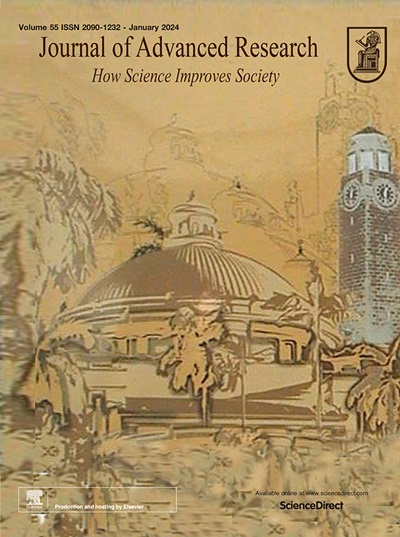Parasympathetic pathway in melatonin regulation exogenous melatonin alleviates abnormal glucose metabolism in the breast muscle under long-term light exposure through the parasympathetic pathway
IF 11.4
1区 综合性期刊
Q1 MULTIDISCIPLINARY SCIENCES
引用次数: 0
Abstract
Introduction
Human beings and animals have been exposed to long-term artificial lighting environments to induce glucose metabolism disorder. Melatonin (MT) is involved in the regulation of glucolipid metabolism, and can prevent skeletal muscle wasting as well as sarcopenia-associated diseases. However, the effect of exogenous MT on skeletal muscle glucose metabolism and the involvement of the parasympathetic pathway have not been clarified. Objectives: To investigate the role of parasympathetic regulatory pathway in the mediating the effects of exogenous MT on skeletal muscle glucose metabolism following long-term light exposure. Methods: This study established rapid growth period broiler models, while characterized muscle histological analysis, glucose metabolism indexes and related genes expression through parasympathetic activation, exogenous MT administration and exogenous MT with parasympathetic inhibition experiments. Results: Long-term light exposure inhibited muscle glycogen synthesis, promoted muscle glycogen decomposition, increased anaerobic glycolysis, decreased aerobic respiration and induced the injury in breast muscle. Parasympathetic activation and exogenous MT caused a marked improvement in muscle glycogen accumulation, aerobic glycolysis and the injury in breast muscle. The exogenous MT beneficial functions were alleviated by parasympathetic inhibition. Furthermore, parasympathetic activation and exogenous MT administration protected cecal microbiota homeostasis, by improving stability of the gut microbiota community and increasing the relative abundance of Lactobacillus. Lactobacillus abundance was positively associated with muscle glycogen accumulation. Conclusion: Taken together, this study highlighted the role of the novel parasympathetic regulatory pathway in the effects of exogenous MT in maintaining glucose metabolism homeostasis and restoring the damage in skeletal muscle with long-term light exposure. The results indicate that gut microbiota are involved in the MT-parasympathetic regulatory network. This study filles the gap in autonomic nervous-endocrine regulation under long light exposure, and provides a new insight to alleviate long light exposure-induced glucose metabolism disorders to improve the growth and health of humans and animals.

褪黑素调节副交感神经通路外源性褪黑素通过副交感神经通路缓解长期光照射下乳房肌肉糖代谢异常
人类和动物长期暴露在人工照明环境中,会诱发葡萄糖代谢紊乱。褪黑素(MT)参与调节糖脂代谢,可以预防骨骼肌萎缩以及肌肉减少相关疾病。然而,外源性MT对骨骼肌葡萄糖代谢的影响以及副交感神经通路的参与尚不清楚。目的:探讨副交感神经调节通路在外源性MT对长期光照射后骨骼肌糖代谢影响中的作用。方法:本研究建立快速生长期肉鸡模型,通过激活副交感神经、外源MT和外源MT结合副交感神经抑制实验,对肌肉组织学、糖代谢指标及相关基因表达进行表征。结果:长期光照抑制肌糖原合成,促进肌糖原分解,增加无氧糖酵解,减少有氧呼吸,引起胸肌损伤。副交感神经激活和外源性MT可显著改善肌糖原积累、有氧糖酵解和胸肌损伤。副交感神经抑制可减轻外源性MT的有益功能。此外,副交感神经激活和外源性MT通过提高肠道微生物群落的稳定性和增加乳酸杆菌的相对丰度来保护盲肠微生物群的稳态。乳酸杆菌丰度与肌糖原积累呈正相关。综上所述,本研究强调了新的副交感神经调节通路在外源性MT维持葡萄糖代谢稳态和恢复长期光照射骨骼肌损伤中的作用。结果表明,肠道微生物群参与了mt -副交感神经调节网络。本研究填补了长时间光照射下自主神经-内分泌调节的空白,为缓解长时间光照射引起的糖代谢紊乱,改善人类和动物的生长和健康提供了新的视角。
本文章由计算机程序翻译,如有差异,请以英文原文为准。
求助全文
约1分钟内获得全文
求助全文
来源期刊

Journal of Advanced Research
Multidisciplinary-Multidisciplinary
CiteScore
21.60
自引率
0.90%
发文量
280
审稿时长
12 weeks
期刊介绍:
Journal of Advanced Research (J. Adv. Res.) is an applied/natural sciences, peer-reviewed journal that focuses on interdisciplinary research. The journal aims to contribute to applied research and knowledge worldwide through the publication of original and high-quality research articles in the fields of Medicine, Pharmaceutical Sciences, Dentistry, Physical Therapy, Veterinary Medicine, and Basic and Biological Sciences.
The following abstracting and indexing services cover the Journal of Advanced Research: PubMed/Medline, Essential Science Indicators, Web of Science, Scopus, PubMed Central, PubMed, Science Citation Index Expanded, Directory of Open Access Journals (DOAJ), and INSPEC.
 求助内容:
求助内容: 应助结果提醒方式:
应助结果提醒方式:


